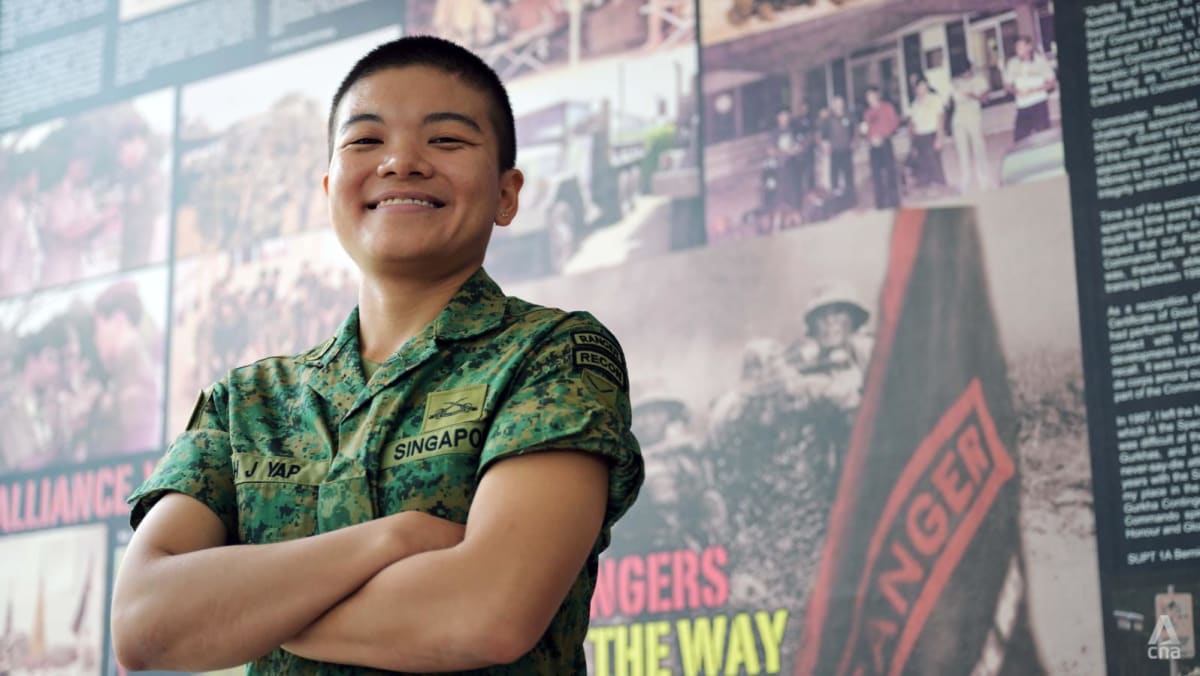SINGAPORE: Back-to-back missions over multiple weeks. A 5km combat evacuation simulation. A coastal swim.
These are just some parts of the Singapore Armed Forces’ (SAF) notoriously gruelling Ranger course, where it is common for soldiers to drop out several times before passing – if they can do so at all.
It took two tries for Captain Yap Hui Jun, who made history by becoming the first woman to complete the course, which was introduced in 1978 and entered its 50th edition this year.
The 27-year-old, who is currently an Intelligence Officer Cadet Course platoon commander, told the media on Tuesday (Oct 24) that she was keen to challenge herself despite knowing it was already rare for non-Commandos to take the course, let alone women.
“I thought the Ranger course was the toughest course in the SAF, and I wanted to see how far I could go and stretch my limits,” she said.
“As the first female, it’s definitely an accomplishment as well as an achievement to many people, but it’s not the main reason why I decided to attend,” she added.
CPT Yap described it as “a good course to discover yourself” and said that she learned a lot in terms of leadership and values.
PREPARATORY PROGRAMME AND SELECTION TEST
During the preparatory fitness conditioning programme, prospective trainees have to complete combat marches of between 4km and 6km while carrying a 20kg field pack, among other requirements.
Then comes the selection test conducted by the Special Forces Leadership School at Pasir Ris Camp, which includes another 8km combat march to be completed within 100 minutes.
Trainees also have to pass a water confidence test comprising a 50m swim in uniform and boots, a 5m confidence jump into the water with a dummy weapon, and the quick removal of combat equipment and weapons underwater.
Pass all this, and the real hell starts.
The Ranger course spans 65 days over three phases. Between the phases, trainees get breaks of a few hours each where they can spend brief periods with their loved ones, eat what they want or stock up on supplies at the Beach Road Army Market.
In the first phase, trainees are tested on their skill-based training competencies. This includes components like boat training, a coastal swim, weapons training, demolition, rappelling and a combat march.
In the second phase, they participate in field training exercises, pulling off back-to-back missions over 20 days.
They then travel overseas to the Shoalwater Bay Training Area in Australia for the third phase, where they complete more field training exercises over a longer duration – 25 days – and distance.
CPT Yap’s first attempt at the Ranger course last year was more challenging, simply because she had no idea what was in store for her. She ended up dropping out during the second phase.
“There’s no way you can really prep for it mentally. (The) physical portion, sure, you can just ramp yourself up, but the mental portion … I think no one will be able to simulate such conditions,” she added.
She noted how the course is meant to simulate combat where soldiers do not get to sleep or eat much.
She pointed out: “As a normal person, if you’re able to get three meals a day, why would you shortchange yourself (by) having one meal a day? … If you can sleep maybe seven, eight hours a day, why would you sleep three, four hours a day to torture yourself basically?”
Not wanting to disappoint her family, friends and bosses, CPT Yap decided to try again.
“They really put in a lot of effort for me to come for this course – especially my colleagues back in my camp, they are doing my job – so it’s not very nice for me to return without a (Ranger) tab,” she said.
Before her second attempt, she made more preparations in terms of planning and better familiarised herself with how small units in the SAF work.
When asked what were the biggest challenges, CPT Yap recounted how she was a machine gunner during their last mission. This meant she had to carry a 15kg machine gun on her shoulder – something that she does not do as a reconnaissance soldier.
“HONOURED AND HUMBLED”
In terms of being the first female Ranger, CPT Yap said she “felt honoured and humbled”, but stressed that it was not the main reason why she joined the course.
“It’s not to prove that I’m the first female to pass the course, saying that females are better than males or whatever. It’s not trying to break any gender equality barriers here,” she added.
“It’s also part of why I signed on – I take it as a challenge and (experienced) self-discovery along the way – but definitely being the first female to pass the course is also something to celebrate.
“I hope this will also encourage more females to sign on or even attempt the Ranger course.”


